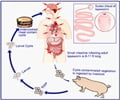An international team of scientists announced on Wednesday they had unravelled the genome of the parasitic worm that causes bilharzia, a disease that each year claims hundreds of thousands of lives.
An international team of scientists announced on Wednesday they had unravelled the genome of the parasitic worm that causes bilharzia, a disease that each year claims hundreds of thousands of lives.
The breakthrough could throw open the way to new drugs to fight a curse that rivals malaria and tuberculosis in many tropical countries, they said.In fact, the blood fluke's genetic profile suggests it may be vulnerable to treatments already used for other diseases, the investigators said.
Bilharzia, also called schistosomiasis or snail fever, occurs when people bathe or wade in river or lake water inhabited by tiny snails that are the parasite's intermediate hosts.
The snails release the microscopic, fork-tailed parasites into the water, and these burrow into the bather's skin.
From there, they travel in the blood to the urinary and intestinal organs, including the liver, where they mature. The worms can grow up to a centimetre (0.4 of an inch) long and live five to 10 years on average in humans, although the record is 40 years.
Once inside the body, the parasites reproduce -- the female worm lives inside the thicker male -- and release thousands of eggs.
Advertisement
People infected with the fluke can suffer internal bleeding, organ damage, diarrhoea and anaemia.
Advertisement
The new probe, published in the British journal Nature, gathered scientists from the United States and Europe in a years-long endeavour to crack Schistosoma mansoni's genetic code.
The sequence "catapults schistosomiasis research into a new era," said Matthew Berriman of Britain's Wellcome Trust Sanger Institute, who co-led the research.
"It provides a foundation for understanding aspects of the parasite's complex biology as well as a vehicle to try to immediately identify new targets for drug treatment."
The creature's DNA comprises 363 million nucleotides, or "letters" in the genetic code, encompassing at least 11,809 genes.
Analysis suggests that for all of its simplicity, the worm has become a smart survivor in murky waters.
Evolutionary pressure has given it sophisticated sensors, enabling it to detect a potential host through changes in chemicals, light levels and temperature.
Publication of S. mansoni comes alongside that of S. japonicum, another source of the disease, by Chinese scientists.
It marks the first time that members of Lophotrochozea, a poorly-explored group of intervertebrates, have had their genome revealed.
A cheap, effective drug to tackle bilharzia already exists -- a treatment called praziquantel.
The worry, though, is that it does not prevent people from getting re-infected by bathing in infested waters, and reinfection offers plenty of opportunities for the parasite to become resistant.
Opening up the genome thus opens up new paths for drugs that can block the parasite at various points in the cycle -- the moments of human infection and replication, for instance.
But there could already be promising parasite-busters in existing drugs.
By matching parasite genes to known drug molecules, the team found more than 90 candidates, although these first have to be thoroughly tested to see if the hunch is right.
"Chronic infection with schistosoma parasites makes life miserable for millions of people in tropical countries around the globe, and can lead to death," said Anthony Fauci of the US National Institute of Allergy and Infectious Diseases (NIAID), which supported the research.
"New drugs and other interventions are badly needed."
Source-AFP
LIN









